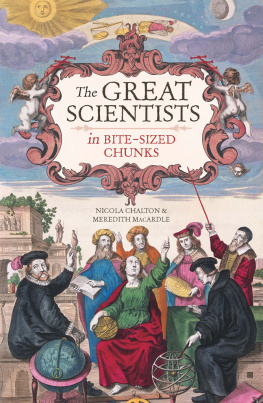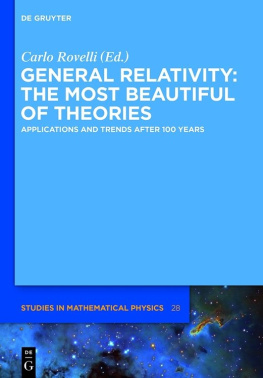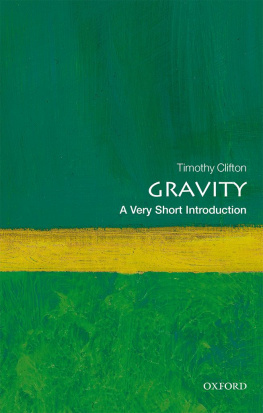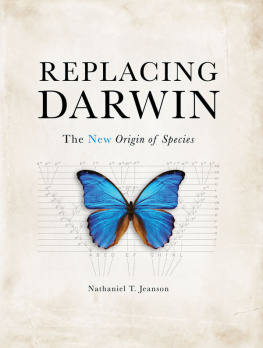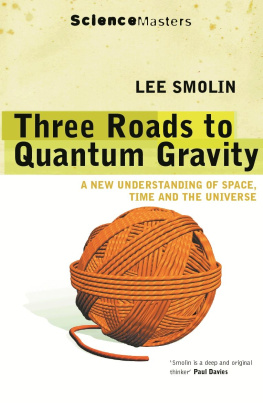This edition first published in 2019
First published as The Great Scientists in Bite-sized Chunks in Great Britain in 2015 by
Michael OMara Books Limited
9 Lion Yard
Tremadoc Road
London SW4 7NQ
Copyright Basement Press 2015, 2019
All rights reserved. You may not copy, store, distribute, transmit, reproduce or otherwise make available this publication (or any part of it) in any form, or by any means (electronic, digital, optical, mechanical, photocopying, recording or otherwise), without the prior written permission of the publisher. Any person who does any unauthorized act in relation to this publication may be liable to criminal prosecution and civil claims for damages.
A CIP catalogue record for this book is available from the British Library.
ISBN: 978-1-78929-071-4 in paperback print format
ISBN: 978-1-78929-177-3 in e-book format
Designed and typeset by Basement Press (www.basementpress.com)
Illustrations by Pascal Thivillon
www.mombooks.com
To Felix, who wants to be a scientist one day.
Contents

S CIENCE TODAY HAS two meanings: the investigation of the world around us, and the way in which such investigations are carried out the scientific method. Different branches of science explore literally everything in the universe, from its origins to its tiniest particles, from the human body to rocks and minerals, and from the power of lightning to invisible forces such as X-rays, radioactivity and gravity.
While our earliest human ancestors probably looked up at the night sky and wondered how the world came about, or collected the first medicinal plants, the scientific method itself is relatively new. Many early investigators just proposed their own particular hypothesis about something, and did not think of testing that theory through carefully conducted experiments that could be repeated again and again to reach the same results. Today it would be unthinkable for a scientist not to offer thoroughly tested evidence for a new theory. In some disciplines, such as astronomy, it is not always possible to carry out experiments, but predictions of events and observations can be used to verify, or reject, a hypothesis.
Early proponents of some form of empirical scientific method include ancient Greek philosopherscientists, the Arab optical specialist Ibn al-Haythem, the medieval English monk Roger Bacon and the Italian astronomer Galileo Galilei. But the major change in scientific attitudes came in the seventeenth century with the approach by one of sciences great minds, Isaac Newton. He proposed rules of reasoning that encompassed propositions and experiments, and very soon all investigators into nature were adopting his method.
In most scientific disciplines there is an understanding that a proven hypothesis might be accepted as a scientific truth, but only until a new theory might disprove it and offer a new paradigm. In this way science develops and expands as new ideas displace old ones. The exception is mathematics, where once a theorem is shown to be true, it is permanently so. It can never be disproven. In fact mathematics, though scientific in the broader sense of involving systematic and formulated knowledge, differs quite considerably from the natural sciences, which investigate the physical universe. Where the natural sciences gather empirical evidence to devise and refine descriptions or models of aspects of the physical universe, mathematics gathers proofs for necessary truths. However, mathematics provides the language in which the natural sciences aspire to describe and analyse the universe, and in this respect it is strongly linked to the sciences.
Science is often coupled with technology too, for many scientific discoveries and advances lead to technological changes: the invention of the light bulb, credited to Thomas Edison, relied upon centuries of scientific exploration of electricity; exploration of space has given us calendars and advanced ceramic technology as used in spacecraft, among many other benefits. From medical technology to the computers and smartphones that we could not live without, science has impacted on everyday life in every way.
Of course, science would not exist without people who are passionate about finding out how the world works. This book reveals some of the great scientists throughout history who have shaped our understanding of the universe.

S INCE ANCIENT TIMES , humans have tried to make sense of the universe by observing objects beyond our world the sun, moon, stars and planets. Babylonian and Egyptian civilizations, realizing that astronomical events are repeated and have cycles, charted star positions and predicted celestial events such as eclipses, comets and the motions of the moon and the brightest stars. Their records formed the basis for timekeeping and navigation.
Adopting centuries of observations before them, the ancient Greeks named groups of stars, or constellations, after mythological figures like Orion, the hunter, and Gemini, the twins Castor and Pollux. The forty-eight Western constellations listed by Ptolemy in the first century are among the eighty-eight constellations used to navigate the night skies today. Likewise, the Romans gave us the names for some of our planets: Mercury, Venus, Mars, Jupiter and Saturn. Reflecting the sun, these were seen as bright stars in the sky.
The invention of the optical telescope in the seventeenth century changed forever the idea of an earth-centred universe. It was soon clear that the universe was much larger than ever imagined. Searching deeper into space, astronomers found more planets of our solar system (Uranus and Neptune), minor planets or asteroids, satellites (moons), dwarf planets (like Pluto), gas clouds, cosmic dust and whole new galaxies.
Todays astronomical instruments include satellite-borne telescopes that detect radiation from faraway cosmic objects, and space probes that can bring back information from other planets. Armed with these tools, astronomers are discovering more about the particles and forces that make up the universe, the processes by which stars, planets and galaxies evolve, and how the universe began. They have also discovered a large part of the universe that cannot be seen with any type of telescope. This dark matter is proving to be one of astronomys greatest mysteries.
Early Star Catalogues: Gan De
Chinese astronomer Gan De (c. 400 to c. 340 BCE ) and his contemporary Shi Shen are believed to be the first named astronomers in history to compile a list of stars, or star catalogue. Gan De lived during the turbulent Warring States period of ancient China, when the regular twelve-year passage across the skies of the bright, visible light of Jupiter, the largest planet in our solar system, was used to count years, so it was the focus of concentrated observations and predictions. Without telescopes, Gan De and his colleagues had to rely on the naked eye, but they made acute calculations to guide them as to the best times to make celestial observations.
In the night sky above mainland China, Gan De saw and catalogued more than a thousand stars, and he recognized at least a hundred Chinese constellations. His star catalogue was more comprehensive than the first-known Western star catalogue, drawn up 200 years later by the Greek astronomer Hipparchus, who listed about 800 stars.




